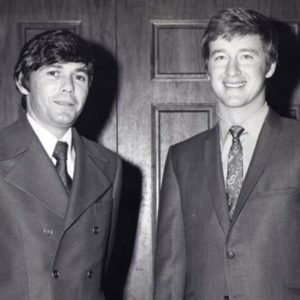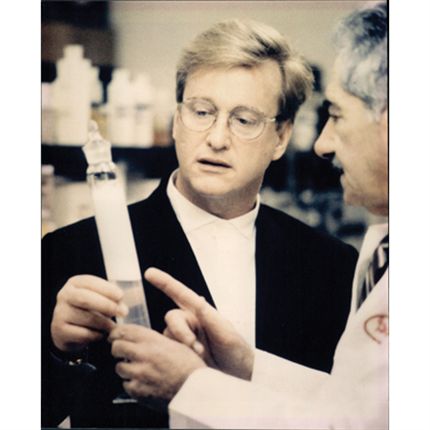What Paul Newman Told Jim Markham…And He Never Forgot It
Celebrity styling, professional education, natural ingredients and sulfate-free color: this is how they all started.
Building a career with celebrity clients. Bespoke professional products. Natural, vegan ingredients. Sulfate- and salt-free color care. All of these are a matter of course in salons today, but that wasn’t always the case. Jim Markham, the founder of ColorProof Evolved Color Care—and before that, PureOlogy Serious Colour Care, ABBA Pure & Natural and Markham Products—was the first to understand how all of these things could improve and propel the careers of professionals—including his own. Originally a champion hairstylist and salon owner from New Mexico, Markham’s insights have completely altered many aspects of the salon business we know today.

Jay Sebring and Jim Markham.
Celebrity Styling
In the late ’60s, a stylist named Jay Sebring owned a salon in Hollywood on the corner of Melrose and Fairfax that attracted the chicest men and women in Southern California, as well as a long list of celebrity clients. Most believe Sebring was one of the models for Warren Beatty’s character in the 1975 movie hit Shampoo. He was young and cool and dated gorgeous actresses including, at one time, Sharon Tate. He had also developed the Sebring line of hair products.
“I was interested in what Jay was doing,” Jim remembers. “I had read in Playboy magazine that he was charging $50 a haircut and was completely intrigued! I wanted to get into product distribution, so I called him and asked if I could distribute his line.” Jim flew to California and the pair struck a deal. He quickly became a Sebring franchisee in four states as well as Jay’s protégé, collaborator and friend. It was during this time that Jim developed a celebrity following of his own—he worked with a long list of prominent stars including Paul Newman, Steve McQueen, Johnny Carson, Robert Redford, Frank Sinatra, William Holden, James Garner, Wolfman Jack and Henry Fonda, to name a few. “I quickly learned Jay’s products and his hair cutting methods extremely well,” says Jim. “He told me that if anything ever happened to him, no one but me could take his place.” And on August 9, 1969, something terrible did happen—Sebring and Tate were gruesomely murdered by Charles Manson and his “family” in Benedict Canyon.
Following Sebring’s murder, Jim took over the business as promised. Within a few months as president, Jim altered the distribution strategy of selling Sebring in boutiques and department stores and put the line exclusively in professional salons. This ended up being a huge turning point for the brand. It was also while with Sebring that Jim realized the natural fit between pairing proper technique with high performance products, which sparked his lifelong interest in product development and innovation.

Jim with his Markham Products investor, Peter Lawford.
By a Professional For Professionals
In 1972, his association with the Sebring group ended and he created Markham Products—one of the very first bespoke professional lines and a forerunner to stylist-named collections like Frederic Fekkai, Sorbie and Rusk. In fact, at the time, there were only a few professional lines at all—Redken was just starting up—and none were helmed by hairdressers. Jim hit the road, educating stylists on his products and his techniques— sometimes accompanied by the actor Peter Lawford, who was President Kennedy’s brother-in-law and a shareholder in the company. At the time, a young British hairdresser named Vidal Sassoon was creating a name for himself. “We did a show together in Dallas,” Jim remembers. “Vidal did the women, and I did the men.” Markham estimates that he taught his Markham method (either directly or indirectly) to upward of 25,000 stylists while he owned the company, paving the way for what would become the standard of manufacturer-driven professional education.

Jim with Vidal Sassoon.
Pure and Natural
After selling Markham Products in 1981, Jim opened a salon and took some time to look around. He was eager to get back into product formulation, and one of his role models was Jheri Redding, the founder of Redken, Jhirmack and Nexxus. “Jheri always made the best products that could be made at the time,” Jim comments, “and then built on that with every subsequent line. That’s what I strived to do. I felt that unless you can create something demonstrably better than what’s currently out there, there’s no point in launching.” In 1988, Jim found a reason and created ABBA Pure & Natural.
At that time, “natural” and “effective” were completely separate concepts. Natural products were mainly health food store mainstays, and while they satisfied consumers’ quests for healthy ingredients, they barely worked, were unstable and were far from fashionable. “I took a fresh look at natural ingredients and worked with our chemists to figure out how to make superior products that truly performed,” Jim explains. “We also made the products 100 percent vegan, which was a first for our industry.”
From his experience with Markham Products, he knew that education was an essential component in any professional company. So he invested heavily, and went up, David and Goliath-style, against the leading educational companies of the ’80s and early ’90s like Redken, Aveda and Sebastian. “We had educators all over the U.S.,” he notes, “which was very unique for such a small company.” The importance of education, in fact, was a lesson that he himself had to relearn. “When we launched PureOlogy,” he notes, “we decided to put all of our resources into great formulas and award-winning packaging. It worked well, but three years later, when we added education, the brand exploded.”

Jim in the lab developing products.
Sulfate- and Salt-Free Color Care
ABBA was sold in 1997, and, once again, it was time to reflect and research. The inspiration for his next venture came about in a very unexpected way. “It started with a phone call. My wife Cheryl’s friend, Kerry, called to say she had been diagnosed with ovarian cancer,” Jim remembers. “She told me that there was nothing on the market that her oncologist would let her use on her hair—she needed formulas that were free of sulfates, salts and any known carcinogens. So I developed hair care products without those ingredients, and they worked great. We gave test samples to a few other people to try, and we immediately noticed that with regular use, haircolor was lasting significantly longer.”
That led to the biggest “aha” of Markham’s career. Recognizing that haircolor services were exploding, women were investing more than ever before in professional color and there was nothing on the professional market designed expressly for color-treated hair, Jim did some quick thinking. As a result, the products he developed for his sick friend and originally planned to market as “carcinogen-free” became PureOlogy Serious Colour Care—and went on to become the biggest success of his career thus far and one of the best-selling lines in the beauty industry. “PureOlogy was the first sulfate-free, salt-free brand exclusively designed for color-treated hair that truly revolutionized the way people care for their hair. We honestly couldn’t understand why nobody else had done a professional color care line before us,” Jim reveals. “When we sold PureOlogy to L’Oréal in 2007, we asked them about it. They confirmed that it had been an oversight!”
Jim’s successes with PureOlogy were well-recognized. He was the recipient of countless awards, including the Ernst & Young Entrepreneur of the Year for all consumer retail products and the Orange County Business Journal Entrepreneur of the Year, to name a few. In addition, he was inducted into the North American Hairstyling Award’s (NAHA) Hall of Leaders and has received the BE! Beautymaker Lifetime Achievement Award.

Jim on the set of a ColorProof photoshoot.
Color Care 2.0
After selling PureOlogy, Jim and Cheryl planned to retire. That lasted about two years. Thinking back to his philosophy about always surpassing one’s own benchmarks, he once again started researching new ingredients. He felt he could build on and improve the quality of ABBA and PureOlogy with brand new ingredient technology to create one more line. “We have so many relationships with research and development chemists and ingredient suppliers who will formulate specific ingredients to meet our standards,” Jim explains. “We can insist on something that most companies can’t get or can’t afford. Most other companies start with a target price and then build a formula around it. We build a formula first and then ensure it is far superior to anything on the market—and only then do we look at price. We call it our unfair advantage—which allows us to top any other product in performance.”
The result of this latest effort, launched in 2012, is ColorProof Evolved Color Care and features state-of-the-art ingredients specified by Markham. In his words, “Not all sulfate-free shampoos are created equal. ColorProof is sulfate-free 2.0. It features a range of next generation ingredients including a proprietary blend of the most gentle, most effective, sulfate-free, salt-free surfactants available. In addition, ColorProof includes potent anti-oxidants and color enhancing ingredients to not only protect haircolor, but also improve hair health and vibrancy. ColorProof always outperforms anything on the market,” Jim comments. “That’s what we aim for, and that’s how we built all of our companies.”
ColorProof may also be the last innovation from the mind of Jim Markham. “Yes,” he laughs, “this is it. We’re happy. We like the people, we like traveling, we like giving back. Paul Newman once told me that in life you either have little luck, medium luck or really big luck. Like Paul, Cheryl and I consider ourselves to be big lucky!”







